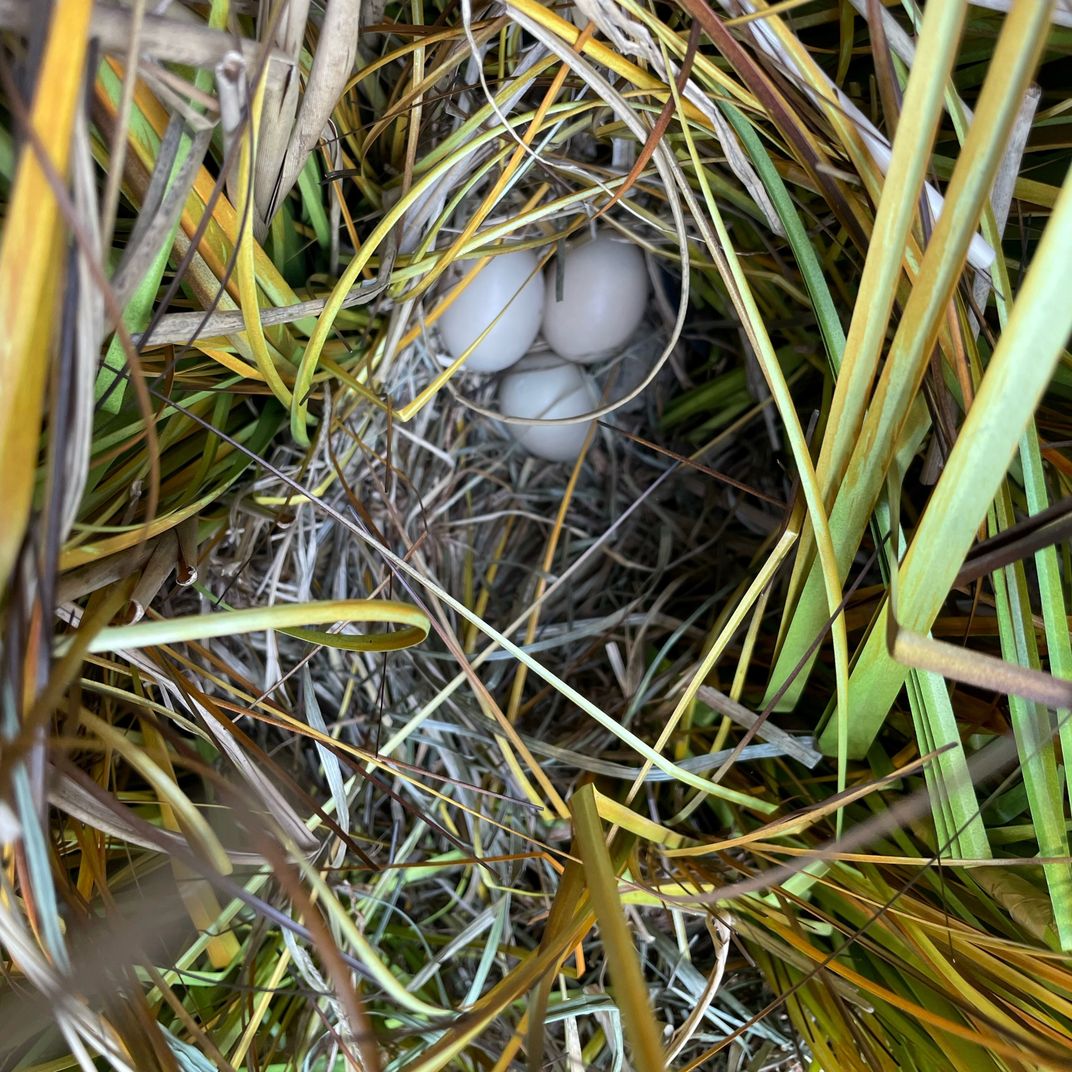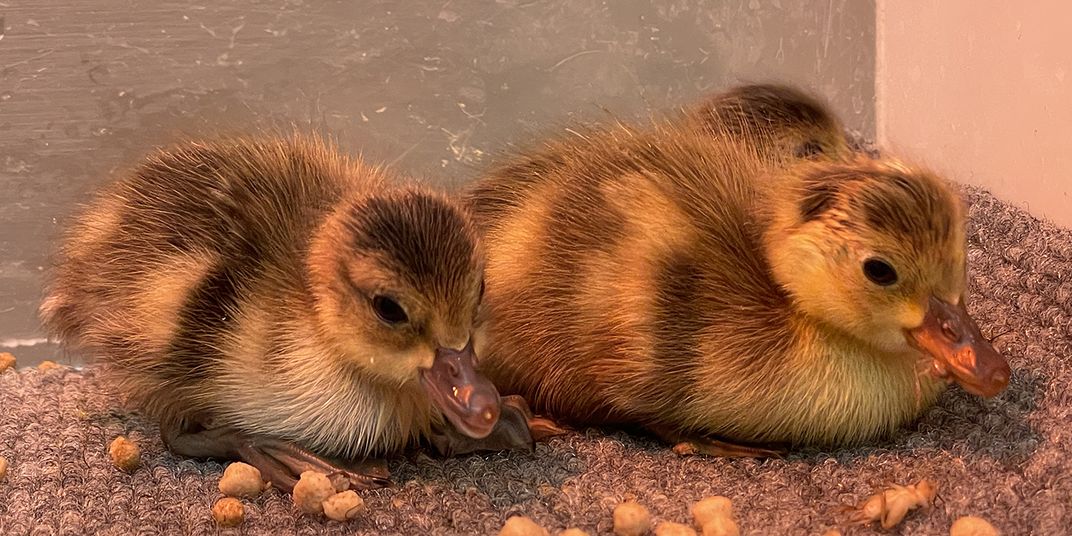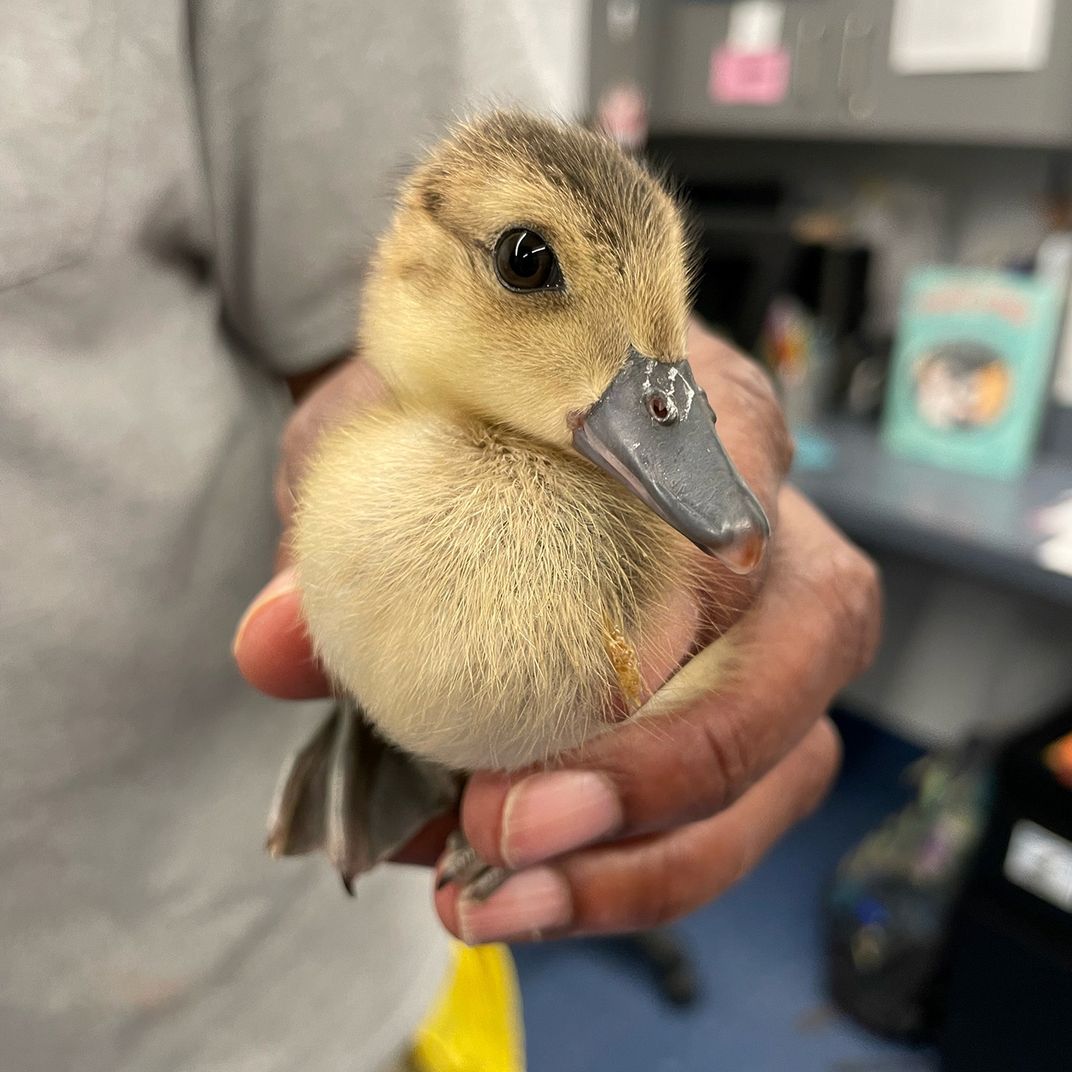NATIONAL ZOO AND CONSERVATION BIOLOGY INSTITUTE
The Love Lives of Ducks Make for Great Drama
Breeding season at the National Zoo’s Bird House can create some spectacular behavior
:focal(2560x1292:2561x1293)/https://tf-cmsv2-smithsonianmag-media.s3.amazonaws.com/filer_public/52/4d/524d52b9-b494-4bea-8cff-679a9501ca9e/20240314-817a7499-05rp-web.jpg)
On a warm spring day at the Zoo’s Bird House, Kevin 2.0 sidles up to Karen and throws his head back. Karen looks on, unimpressed. In the nearby upper pool, Ricky tries to grab the attention of Lucy by chasing everyone out of the water and then swimming around in a wide figure-8 pattern. And in the lower pool, Mia can’t be bothered with Aaron’s head bobbing—she’s just trying to enjoy a snack. He gives up and goes off for a nap.
Despite their names, these aren’t rowdy humans on a reality dating show—they’re the ducks at the Zoo’s Bird House. For Kevin, Mia, Ricky and the rest, springtime means breeding season, the time of year when waterfowl across the Northern Hemisphere are searching for love.
‘North America’s Duck Factory’
The Zoo’s Bird House is home to eight species of ducks, each of which is native to North America. The aviary where they live is called the “Prairie Pothole,” which is also the name for a vast stretch of territory in the upper-midwestern Great Plains.
This Prairie Pothole region is one of the world’s largest wetland habitats. Each spring, rain and melting snow fills millions of shallow ground depressions, carved by ancient glaciers, with enough water to create ponds and mini-lakes. Massive flocks of ducks are drawn to this territory, flying northward on the same migratory routes as countless generations before them. Upon arrival, the ducks mingle, reproduce, raise their young and eventually migrate south before the wetlands dry up each fall. This area is so well-suited for waterfowl breeding that ecologists have nicknamed the region ‘North America’s duck factory’. By some estimates, up to 80 percent of the continent’s duck population can trace their origins here.
Unfortunately, this is a region under threat. As prairie grasslands and scrublands are degraded by commercial agriculture, more critical waterfowl habitat is destroyed each year. Conservation programs like the Smithsonian’s Great Plains Science Program are dedicated to understanding the complex challenges facing these landscapes. And at the Zoo, the goal of the Prairie Pothole aviary is to teach visitors about the importance of this ecosystem and how its removal would affect the animals whose lives depend on the stability of the northern prairie.
The Bird House’s immersive waterfowl aviary is filled with tall grasses, small ponds, an abundance of food and plenty of places to nest—the same habitat features that attract millions of ducks to the prairie each year. But while their wild counterparts must undergo a weeks-long, continent-spanning migration to reach their preferred breeding grounds, the Zoo’s ducks are already situated and ready to mingle.
Hot in Springtime, Cool for the Summer
Like most animals, ducks do not usually mate for life. But many species are seasonally monogamous, pairing up with a mate during breeding season and parting ways by the end of summer.
Starting around late February, the Zoo’s male ducks start molting into their breeding plumage. They also get feisty – a sign that their hormones are surging and they’re actively looking for a mate. Females aren’t usually receptive for a few more weeks. But by March to mid-April, same-species pairs have started to get acquainted, with males chasing away rivals and females staking out nesting territory.
As animal keeper Jen Ferraro jokes, being among the Prairie Pothole aviary’s 8 species of ducks during this time of year is almost like being behind the scenes at a raucous, interspecies soap opera.
“So much drama and intrigue happens here in the springtime. It’s almost like ‘Ducks of our Lives’.”
To find a compatible mate, ducks use courtship displays – mating rituals which can involve a seemingly chaotic mix of wing flaps, head bobs, vocalizations and feather fanning. The right dance moves from a wooing male might convince a female duck she’s found the right partner.
“This time of year, the females are busy trying to find the coolest, best-looking male,” said Ferraro. “And males look cool by molting into their breeding season plumage, setting up a territory to attract females and by showing off their unique courtship displays.”
An egg-laying bonanza
As the season progresses, Bird House keepers take a proactive approach towards making sure each breeding female has a safe place to build a nest and lay eggs. Keepers also provide nesting materials, like hay and aspen shavings, so the ducks can assemble the nests themselves. Most ducks find nest boxes hidden by the keepers among the grasses, although a few species, like the ruddy ducks, prefer to burrow several feet down in the aviary’s soil for nesting.

For safety and well-being reasons, Bird House keepers do not allow ducklings to spend the first few weeks of their lives on exhibit. Females are given time and space to incubate their eggs, but for the ducklings to thrive, animal care staffers need to line up a few alternative options before they hatch.
The first option is for Bird House keepers to pull the viable eggs from the nest a few days before they’re expected to hatch, load the eggs into a travel incubator and hand off the entire clutch to animal care professionals at other accredited zoos and wildlife facilities.

Another option is for the team to identify same-species pairs in the outdoor off-exhibit areas and allow the hatchlings to be raised by willing surrogate parents outside.
The third option is to place the eggs in an off-exhibit incubator, hand-raise the ducks for a few weeks after they hatch, and then reintroduce them into the flock after they can fend for themselves in a few months. Last year, the Zoo hand-raised 11 ducks; some of these individuals are living in off-exhibit areas at the Bird House, and the rest are living at various accredited zoos and wildlife facilities.

These strategies were developed quickly after the Bird House reopened in 2023 after a six-year renovation. Careful identification tracking of each laid egg is needed to make sure the team can be proactive about providing the right level of care.
“Last year, when we introduced the ducks [to their new habitat area], no one expected them to breed. We actually chose ducks who had not bred before,” explained Ferraro. But as Jeff Goldblum famously declared in the movie ‘Jurassic Park’, life finds a way. More than 200 eggs were laid in the Prairie Pothole aviary last year.
“Nearly every day I came into work in late March and early April, there would be more eggs. Every morning, I would walk over to each nest and search for eggs and find new ones. It was like an Easter Egg hunt,” she said.
How You Can Help
Although the ducks in the Prairie Pothole aviary are thriving, wild populations of migratory birds across North America are under threat. Overall, birds across the United States and Canada have declined by 29 percent, or almost 3 billion individuals, since 1970. The avians at the Bird House are here as the result of a multi-institutional effort to understand the life cycles and breeding habits of migratory birds, which will inform conservation leaders as they work to protect animal species in their native habitats.
Wondering what you can do? The best and most effective way to help ducks in North America is to is support programs like the U.S. Fish and Wildlife Service’s Duck Stamp. These programs protect and restore wetlands while compensating farmers and local landowners. The Federal Duck Stamp program alone has helped conserve more than 6 million acres of waterfowl habitat since 1934.
Also, the Smithsonian’s Migratory Bird Center recommends seven simple actions you can take to make your home and lifestyle better for birds and the planet. Even a small change can make a big difference for a bird.

